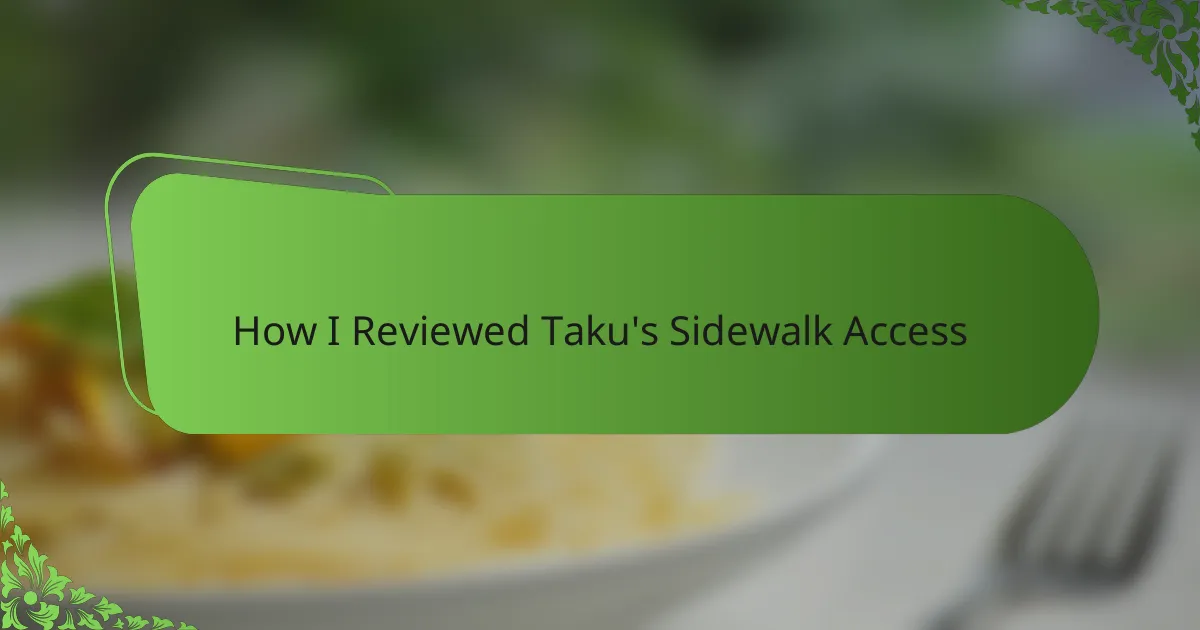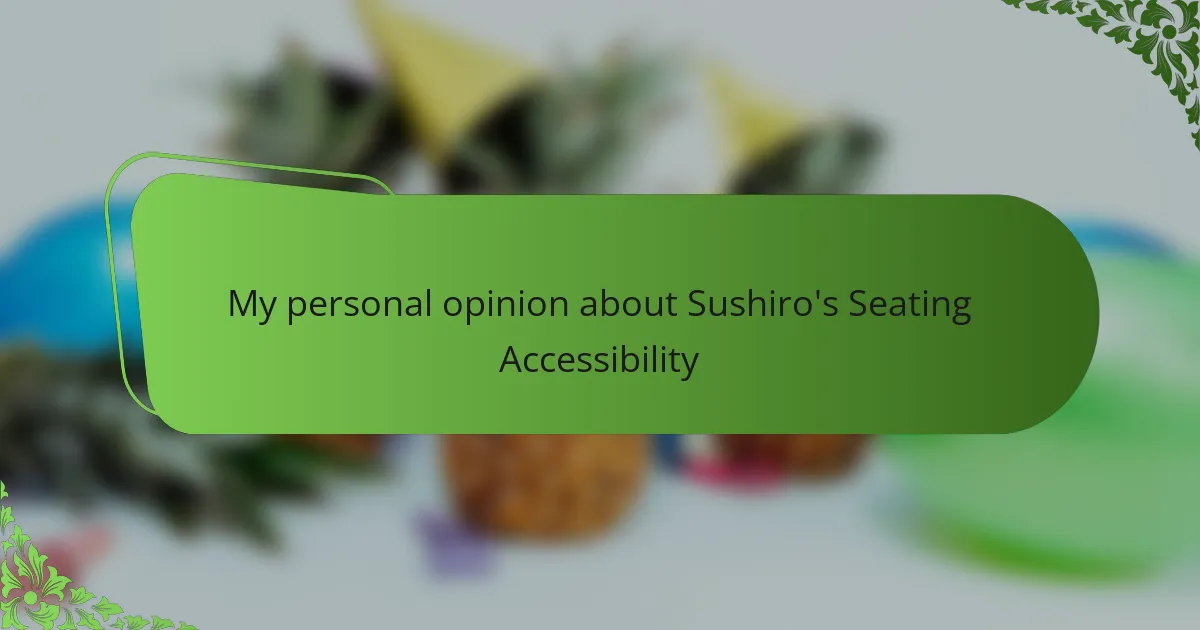Key takeaways
- Accessibility in restaurants involves thoughtful design and features that welcome all patrons, including wide aisles, clear signage, and multiple menu formats.
- Sushi Ko exemplifies accessibility with a spacious layout, easy-to-read menus, and clear, strategically placed signage, enhancing the dining experience for everyone.
- Staff at Sushi Ko provide attentive and respectful assistance, offering clear communication and support while allowing diners to feel comfortable and independent.
- The variety of seating options and flexible ordering methods at Sushi Ko demonstrate a commitment to accommodating diverse needs, enhancing overall guest satisfaction.
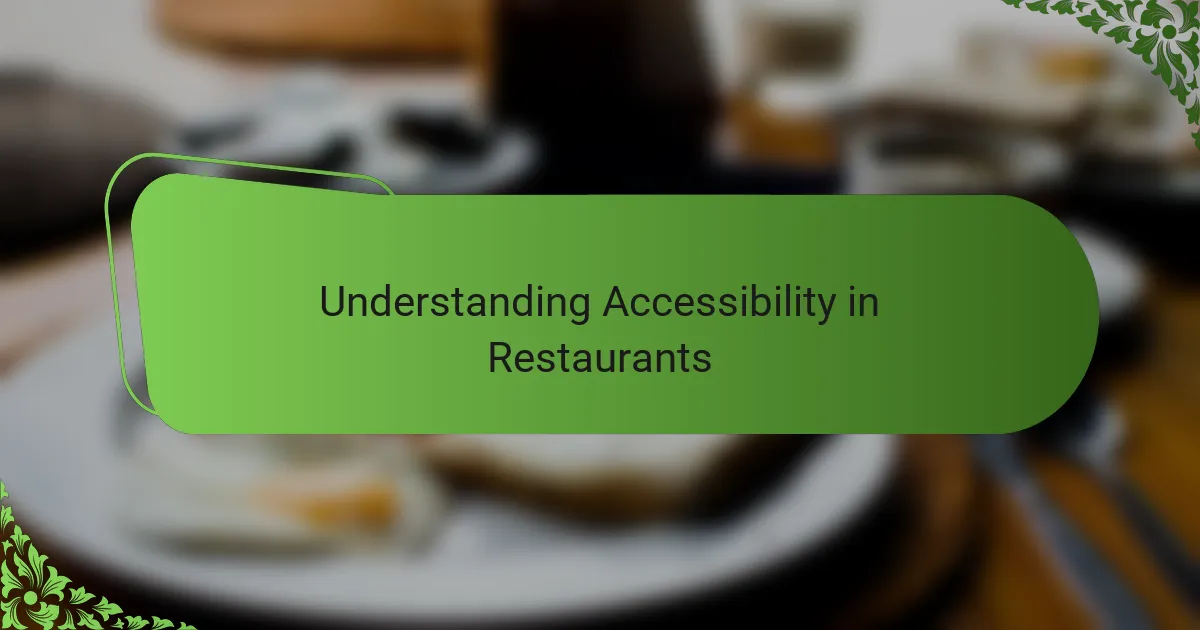
Understanding Accessibility in Restaurants
Accessibility in restaurants goes beyond just ramps at the entrance; it’s about creating an environment where everyone feels welcome and comfortable. I’ve often wondered, how many places truly consider the diverse needs of their guests, from wheelchairs to sensory sensitivities? Observing spaces that thoughtfully integrate accessible features always makes me appreciate the effort to include all patrons.
When I visit a restaurant, I notice details like wide aisles, clear signage, and menus available in multiple formats. These small touches tell me the establishment values more than just serving food—they care about the experience for every individual. It’s interesting how these features can dramatically change someone’s feeling of independence and respect in a public place.
Have you ever thought about how much accessibility impacts a person’s dining experience? From personal experience, eating out can either feel like an exciting outing or a stressful challenge depending on these accommodations. This awareness has taught me to look closer and advocate for better inclusivity in all restaurants.
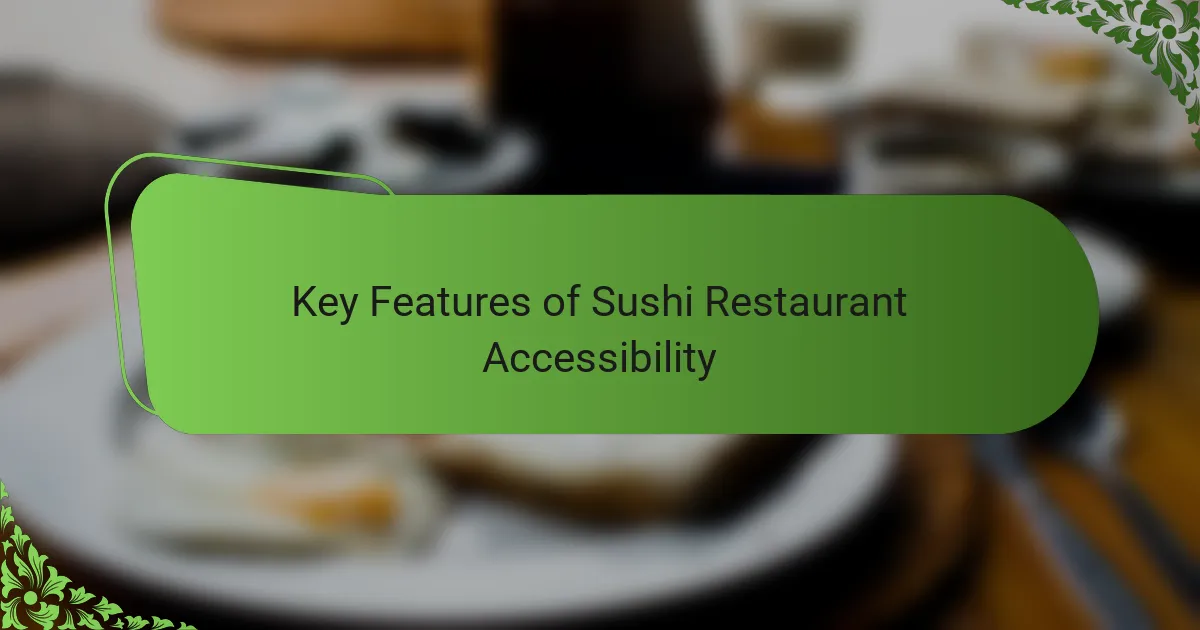
Key Features of Sushi Restaurant Accessibility
One of the key features I always pay attention to in sushi restaurants is the layout—wide aisles and spacious seating make a huge difference. I remember feeling instantly at ease in a place where I could navigate smoothly without worrying about bumping into tables or staff. Isn’t it amazing how something as simple as space can transform a meal into a stress-free experience?
Another aspect that caught my eye was the availability of menus in different formats, such as large print or digital versions on tablets. I once saw a fellow diner’s face light up when handed a menu they could easily read, and it reminded me how vital these small accommodations are. Doesn’t it say a lot about a restaurant’s commitment to inclusion when they think beyond just the food?
Of course, clear and visible signage is a silent hero in accessibility. I’ve found that signs indicating restrooms, exits, or allergen information in bold and intuitive designs remove guesswork and help everyone feel more confident during their visit. Have you noticed how a simple sign can reduce anxiety and make navigating a new place so much easier?
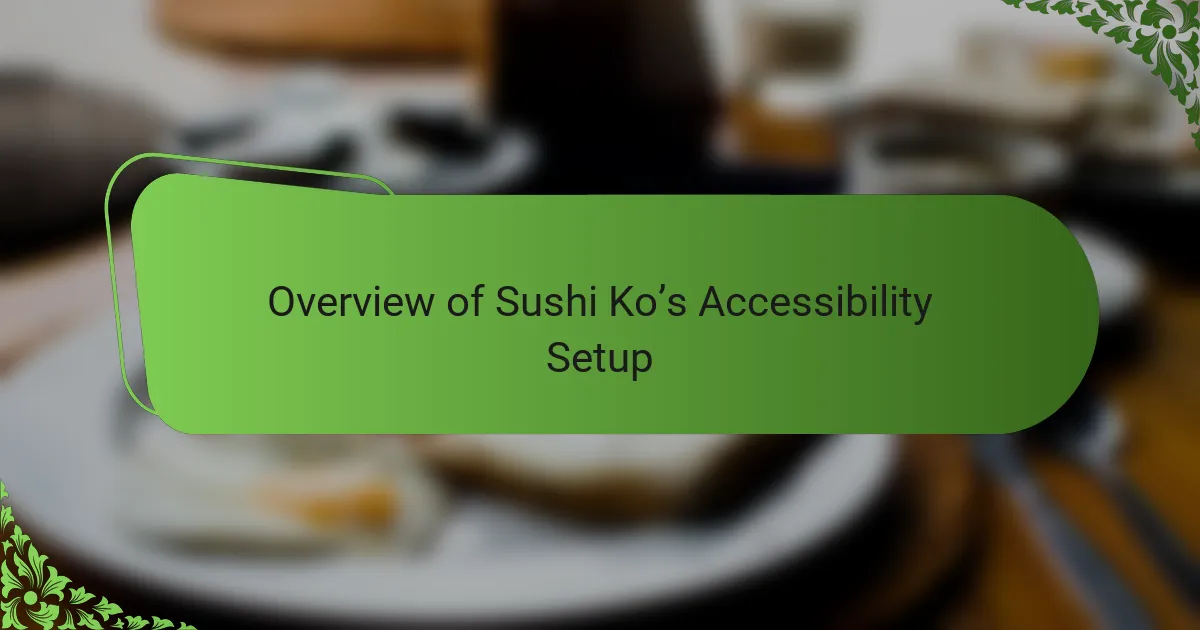
Overview of Sushi Ko’s Accessibility Setup
Walking into Sushi Ko, the first thing I noticed was how thoughtfully the space was arranged. Wide aisles allowed me to move around with ease, and the seating felt neither cramped nor overwhelming. Have you ever experienced a restaurant where just the setup itself calmed your nerves before you even ordered? That was exactly my feeling here.
The menus caught my attention next. Sushi Ko offered printed options in large fonts and even had digital tablets ready to accommodate different needs. I recall thinking how much these little efforts say about a restaurant’s true intention—making sure every diner can engage fully without stress or struggle.
Then there was the signage—simple, clear, and strategically placed. Finding restrooms or allergy info didn’t require guesswork, which I found surprisingly comforting. Isn’t it interesting how something as subtle as a well-designed sign can create a sense of ease and belonging? Sushi Ko seemed to get this just right.

Assessing Entrance and Seating Options
The entrance to Sushi Ko immediately struck me as welcoming—not just because it was smooth and ramped, but because the doorway was wide enough to invite all kinds of guests without hesitation. Have you ever reached a restaurant and felt instantly unsure whether you’d even get through the door comfortably? That sense of welcome (or the lack of it) sets the tone before you even see a menu.
Inside, the seating layout showed real thoughtfulness. Tables were spaced generously, allowing room to maneuver without feeling like you were intruding on someone else’s meal. I remember sitting down and realizing I didn’t have to awkwardly shift or ask for help, which, honestly, made a big difference in how relaxed I felt.
What stood out most was the variety in seating options. For those who prefer booths, bar seating, or standard tables, Sushi Ko offered choices that accommodated different needs and preferences. Isn’t it great when a restaurant anticipates that dining comfort isn’t one-size-fits-all? That attention to detail says a lot about their commitment to accessibility.
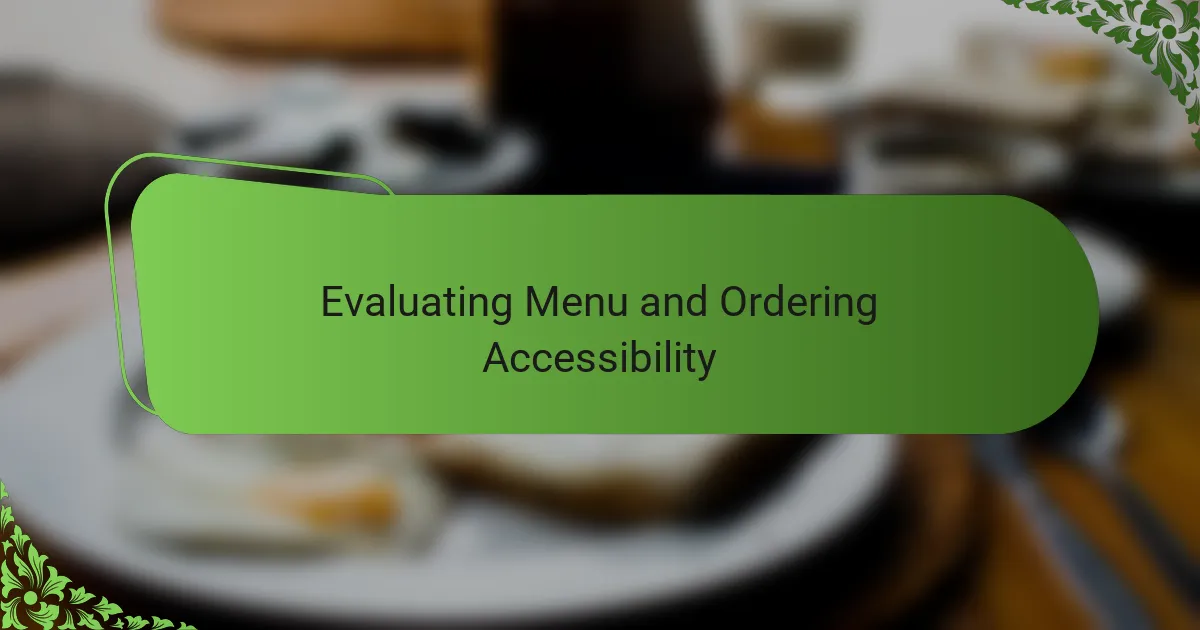
Evaluating Menu and Ordering Accessibility
When it came to evaluating Sushi Ko’s menu and ordering process, I immediately noticed the thought put into accessibility. Having menus in both large print and digital formats on tablets made it easy for me to choose without straining my eyes or feeling rushed. Have you ever struggled with tiny fonts or complicated menus that make ordering more stressful than enjoyable? This simple choice at Sushi Ko truly made the experience smoother.
I also appreciated how the staff were ready to assist without being intrusive. When I asked about allergen information, the server confidently guided me through options using clear language and even referred to the digital menu to highlight safe choices. From my perspective, that kind of attentive support shows how seriously a restaurant takes accessibility beyond just materials—it’s about thoughtful interaction.
Ordering at Sushi Ko felt inclusive because the process seemed designed to accommodate diverse needs. Whether you prefer to order at the bar, from a table, or via touchscreen, the flexibility struck me as a sign that no patron’s comfort or independence was overlooked. Don’t you think that having multiple ways to order empowers diners to engage on their own terms? It’s these details that transformed a simple meal into a welcoming experience.

Staff Assistance and Communication Practices
What really impressed me about Sushi Ko was how naturally the staff stepped in to help without making you feel like you were any different. I remember once asking for suggestions about dietary restrictions, and the server didn’t just recite a list—they took the time to explain options patiently, which made me feel genuinely cared for. Have you ever experienced that kind of attentiveness where the interaction feels more like a conversation than a transaction?
Communication at Sushi Ko felt easy and respectful, too. The staff were quick to pick up on little cues, like if someone needed more time or preferred written information rather than verbal explanations. From my experience, that kind of sensitivity transforms what could be an awkward moment into something smooth and welcoming. Isn’t it refreshing when you don’t have to ask twice or worry about being misunderstood?
I also noticed how staff checked in periodically but without hovering, which struck me as perfectly balanced. It made me realize that accommodating diverse needs isn’t about being overly involved—it’s about genuine attentiveness and respect. Have you ever left a restaurant feeling both seen and left to enjoy your meal in peace? That’s the kind of thoughtful service I saw at Sushi Ko.

